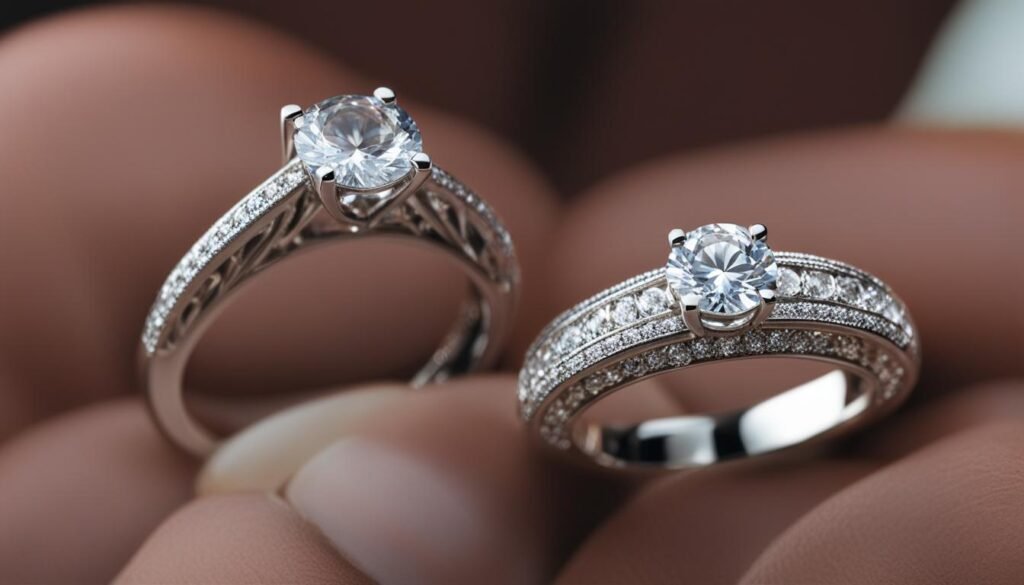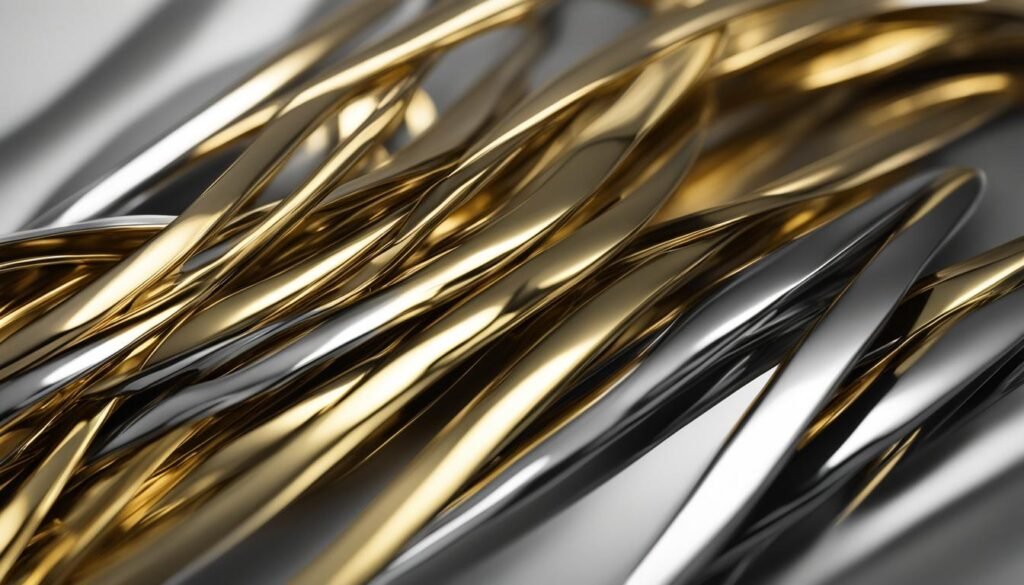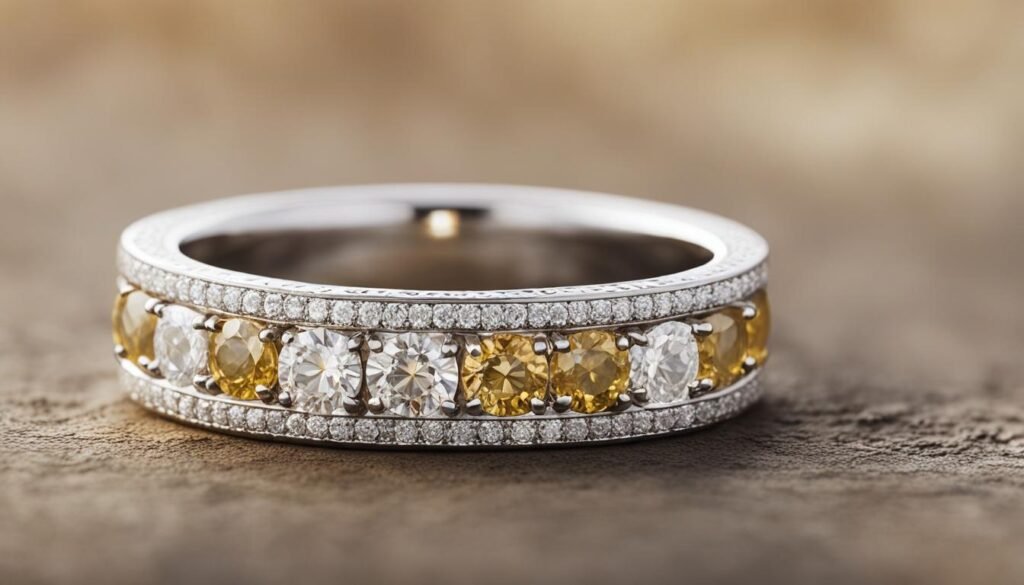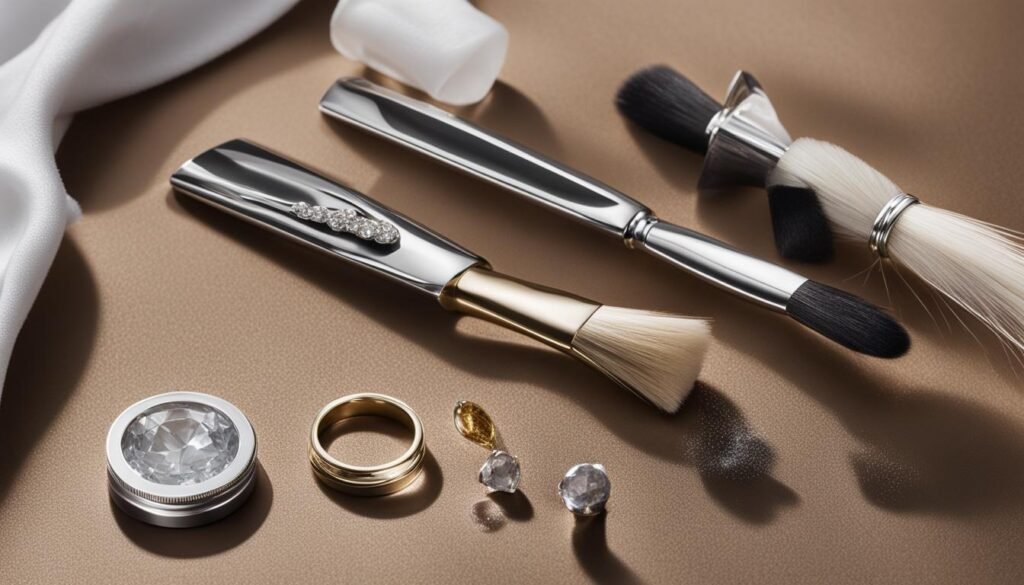Why Does White Gold Turn Yellow Over Time?
White gold is a popular choice for jewelry due to its durability, elegance, and versatility. However, over time, white gold jewelry may start to lose its white color and appear yellow.
This phenomenon can be confusing and frustrating for those who own white gold pieces. In this article, we will explore the reasons behind white gold turning yellow and discuss the factors that contribute to this color change.
We will also provide insights into how you can maintain the luster of your white gold jewelry and prolong its lifespan.
Key Takeaways
- White gold can turn yellow over time due to factors like the composition of the alloy and external influences.
- White gold is created by mixing pure gold with other metals to enhance its strength and durability.
- Rhodium plating is commonly used to maintain the white appearance of white gold jewelry.
- Proper maintenance and cleaning can help prolong the luster of white gold jewelry.
- Allergies to metals like nickel have led to the use of palladium as an alternative alloy in white gold.
The True Nature of White Gold
Contrary to popular belief, pure white gold does not exist in nature. White gold is created by mixing pure gold with other metals to enhance its strength and durability. The addition of these metals also imparts the distinct white color that makes white gold such a beloved choice for jewelry.
Unveiling the Myth of Pure White Gold
Many people mistakenly assume that white gold is a natural form of gold, similar to yellow gold. However, this is not the case. Pure gold, in its natural state, is actually yellow. It is the combination of gold with other metals that transforms it into white gold, giving it a strikingly different appearance.
White gold became popular in the 1920s as an attractive and more affordable alternative to platinum. Its unique color and shimmering elegance quickly captured the attention of jewelry enthusiasts.
Understanding Gold Alloys and Karatage
Gold alloys play a crucial role in the creation of white gold. By blending pure gold with other metals, such as nickel, zinc, or palladium, jewelers are able to achieve the desired color and improve the durability of the final product. The proportion of these additional metals ultimately determines the specific shade of white gold.
The karatage of white gold is another important factor to consider. Karatage refers to the percentage of pure gold in the alloy. Most white gold jewelry is typically available in 14 karat or 18 karat options. While 14 karat white gold contains approximately 58% pure gold and 42% other metals, 18 karat white gold contains about 75% pure gold and 25% other metals. The higher the karatage, the more pure gold is present in the alloy, resulting in a richer color and higher value.
| Karatage | Gold Content (%) | Other Metals Content (%) | Color |
|---|---|---|---|
| 14K | 58 | 42 | Lighter |
| 18K | 75 | 25 | Richer |
The Science Behind White Gold’s Color Change
Understanding the composition of white gold and its natural hue is crucial to comprehending the reasons behind its color change. White gold is an alloy made by combining pure gold with other metals, such as silver, palladium, or nickel. The addition of these metals alters the color of gold, resulting in a white or grayish appearance.
Buy Gold Online: The Smart and Secure Way
Discover the safest and most reliable strategies to buy gold online. Make informed investment decisions and secure your financial future today!
Learn MoreThe natural color of white gold, without any additional treatments or platings, has a slightly yellowish tint compared to pure silver or platinum. This subtle hint of yellow is due to the presence of other metals in the alloy composition.
Rhodium plating is a common technique used in the jewelry industry to enhance the whiteness of white gold. Rhodium, a metal in the platinum family, is applied as a thin layer onto the surface of white gold pieces. The rhodium plating gives white gold jewelry a bright, reflective, and pure white appearance, effectively concealing any yellowish tints.
By using rhodium plating, jewelers can provide a consistent and attractive color for white gold jewelry. However, it’s important to note that rhodium plating is not a permanent solution. Over time, the thin layer of rhodium can wear off, revealing the natural color of white gold underneath.
So, while the composition of white gold and the role of rhodium plating contribute to its color change, it’s essential to understand that white gold’s natural hue may differ from the pure white color associated with other metals.
External Factors That Influence White Gold Yellowing
While the composition of white gold is a primary factor in its color, several external factors can also contribute to its yellowing over time. Understanding these influences is essential in maintaining the aesthetic appeal and quality of your white gold jewelry.
Skin Oils and Daily Wear
One significant factor that can impact the color of white gold is the natural oils present on our skin. When we wear white gold jewelry daily, these oils can gradually accumulate, leading to discoloration. The oils can react with the metals in the white gold alloy, causing it to appear yellowish.
To minimize the effects of skin oils on your white gold jewelry, it is essential to clean your pieces regularly. Use a mild soap and warm water to gently remove any oil buildup. You can also consider removing your white gold jewelry when engaging in activities that may cause excessive sweating or oil production.
Environmental Exposure and Chemical Reactions
Another external factor that can influence the color of white gold is environmental exposure. Exposure to certain chemicals, such as chlorine or household cleaning agents, can cause the white gold to undergo chemical reactions, resulting in discoloration.
In addition to chemical exposure, environmental conditions like humidity and air pollution can impact the color of white gold. Over time, these factors can contribute to the yellowing of white gold jewelry.
To mitigate the effects of environmental exposure, it is advisable to remove your white gold jewelry when engaging in activities that may expose it to chemicals or extreme environmental conditions. Storing your white gold pieces in a clean and dry environment can also help maintain their appearance.

| External Factors | Impact on White Gold |
|---|---|
| Skin oils and daily wear | Can cause yellowing due to oil buildup and reaction with white gold alloys |
| Environmental exposure and chemical reactions | May lead to discoloration through chemical reactions and exposure to pollutants |
Does white gold turn yellow?
Now that we have explored the composition and factors that contribute to white gold’s color change, let’s address the pressing question: does white gold actually turn yellow? The answer is yes, white gold can indeed turn yellow over time.
White gold jewelry is typically plated with rhodium, a shiny and reflective metal from the platinum family, to enhance its whiteness and durability. However, this rhodium plating eventually wears off, revealing the natural yellowish hue of the white gold alloy beneath.
As mentioned earlier, white gold is created by mixing pure gold with other metals such as silver, palladium, or nickel. These alloys can contain a certain percentage of yellow metals, which can cause the gold to appear yellowish over time.
This image showcases an example of white gold discoloration, illustrating the subtle yellow tint that can develop.
It’s important to note that the rate at which white gold turns yellow can vary depending on various factors, including the alloy composition, individual body chemistry, and the level of wear and exposure to environmental elements.
If you notice your white gold jewelry starting to show signs of discoloration, it doesn’t necessarily mean that the piece is of poor quality. Rather, it is a natural occurrence that can be managed and treated.
In the next section, we will discuss some preventive measures and maintenance tips to help slow down the yellowing process and keep your white gold jewelry looking its best for longer.
Comparing Durability: White Gold Versus Other Precious Metals
When it comes to durability, white gold often finds itself in discussions and comparisons with other precious metals such as platinum, yellow gold, and silver. Understanding how white gold measures up against these metals can help you make an informed decision when choosing your jewelry.
Let’s take a closer look at the advantages and limitations of white gold in comparison to these metals.
1. Durability:
While white gold is known for its durability, it is important to note that it is not as strong as platinum. Platinum, being one of the densest metals, offers exceptional durability and resistance to wear and tear. Yellow gold, on the other hand, is relatively softer than both white gold and platinum, making it more prone to scratches and dings. Silver is the softest of the four metals and requires regular maintenance to prevent tarnishing and wear.
2. Strength:
Platinum reigns supreme when it comes to strength. Its density and inherent hardness make it an excellent choice for those seeking long-lasting pieces. White gold, with its alloy composition, provides good strength and is suitable for everyday wear. Yellow gold, although not as durable as platinum or white gold, still offers sufficient strength for jewelry. Silver, being the softest of the metals, is less robust and prone to bending or breaking under stress.
3. Resistance to Wear:
Both white gold and platinum have excellent resistance to wear, making them suitable for everyday use. Yellow gold, while durable, may show signs of wear more quickly due to its softer nature. Silver, being the softest metal, is more susceptible to scratches and dents.
4. Appearance:
White gold and platinum share a similar appearance due to their white color. Both metals offer a lustrous and sophisticated look that complements various gemstones. Yellow gold, on the other hand, has a warm and classic allure. Silver has a bright and shiny appearance but requires regular polishing to maintain its shine.
Here’s a visual comparison of the durability of white gold, platinum, yellow gold, and silver:
| Metal | Durability | Strength | Resistance to Wear | Appearance |
|---|---|---|---|---|
| White Gold | Good | Good | Excellent | Elegant and white |
| Platinum | Excellent | Excellent | Excellent | Elegant and white |
| Yellow Gold | Moderate | Moderate | Good | Classic and warm |
| Silver | Moderate | Weak | Moderate | Bright and shiny |

Remember, the durability of your jewelry also depends on factors such as design, craftsmanship, and how you care for it. Regular maintenance and proper handling can help prolong the lifespan of your favorite pieces.
Rhodium Plating: The Temporary Beauty Treatment for White Gold
White gold jewelry is renowned for its stunning appearance, but over time, it may start to lose its lustrous white color and develop a yellowish tint. To restore its original brilliance, many people turn to rhodium plating.
Understanding Rhodium’s Role in Jewelry
Rhodium is a precious metal in the platinum family, known for its high reflectivity and resistance to corrosion. When white gold jewelry undergoes rhodium plating, a thin layer of rhodium is electroplated onto the surface, creating a bright, white, and reflective finish. This process not only restores the white color but also enhances the overall shine and aesthetic appeal of the jewelry.
One of the main advantages of rhodium plating is its ability to provide a high level of protection to white gold jewelry. The rhodium layer acts as a barrier between the metal and external elements, preventing tarnishing, scratching, and general wear and tear. It also helps minimize the impact of skin oils and environmental factors that can cause yellowing or discoloration.
Furthermore, rhodium plating is a reversible process, meaning that if you decide to change the appearance of your white gold jewelry in the future, the rhodium layer can be removed, revealing the original metal underneath.
Wear and Tear: The Lifespan of Rhodium Plating
While rhodium plating is an excellent way to maintain the beauty of white gold, it is essential to understand that it is not a permanent solution. Over time, the rhodium layer may start to wear off, revealing the natural color of the white gold underneath. The lifespan of rhodium plating can vary depending on several factors, including the frequency of wear, the wearer’s body chemistry, and the level of care and maintenance.
Typically, a rhodium-plated white gold piece may require re-plating every 1 to 3 years to maintain its desired appearance. However, this may vary depending on individual circumstances. It is recommended to consult with a professional jeweler who can assess the condition of your jewelry and provide personalized advice on when re-plating is necessary.

| Pros of Rhodium Plating | Cons of Rhodium Plating |
|---|---|
|
|
The term “tarnishing” is often used to describe the color change in white gold. However, it is important to clarify the misconception surrounding white gold tarnishing and distinguish it from discoloration and damage. Tarnishing usually refers to the process of surface corrosion and discoloration that occurs in metals like silver. In the case of white gold, discoloration is a more accurate term to describe the color change over time.
Distinguishing Discoloration from Damage
Discoloration in white gold is a natural occurrence and should not be confused with damage. Over time, the alloys in white gold jewelry can undergo oxidation, causing the metal to change color. This discoloration is a result of various factors, such as exposure to environmental elements, chemicals, and skin oils. It is a normal process that can be managed and minimized with proper care.
It is important to note that discoloration does not necessarily indicate damage to the jewelry. While the aesthetics may be affected, the structural integrity and value of the white gold remain intact. Discoloration can be reversed or corrected through professional cleaning and maintenance.
Discoloration: A Natural or Synthetic Issue?
Discoloration in white gold jewelry can occur in both natural and synthetic forms. Natural discoloration refers to the gradual change in color that occurs over time due to exposure and wear. This type of discoloration is a result of the chemical reactions and oxidation processes that take place in the metal. It is a common phenomenon that happens to all white gold jewelry and is not indicative of any manufacturing or quality issues.
On the other hand, synthetic discoloration can occur when white gold is poorly manufactured or improperly alloyed. This type of discoloration may be more severe and can be a sign of manufacturing defects or an inferior quality alloy. However, with proper care and maintenance, both natural and synthetic discoloration can be managed and minimized.
Overall, understanding the difference between tarnishing, discoloration, and damage is essential for navigating the misconceptions surrounding white gold. By recognizing discoloration as a natural occurrence and distinguishing it from damage, you can better care for your white gold jewelry and maintain its luster and beauty over time.

The Love for Authenticity: Embracing the Natural Tint of White Gold
While many people desire the pure white appearance of white gold, there is a growing appreciation for the authentic charm and character that comes with the natural tint that develops over time and wear. This yellowish hue adds a unique warmth and depth to white gold jewelry, making each piece truly one-of-a-kind.
Embracing the natural tint of white gold allows you to showcase the unique journey and history of your jewelry. It is a testament to the authenticity and individuality of each piece, reflecting the memories and experiences associated with wearing it.
“The natural tint of white gold adds a touch of character and nostalgia to the jewelry, making it more than just a piece of metal. It tells a story and enhances its value.” – Jewelry enthusiast
By embracing the natural tint of white gold, you are appreciating its inherent beauty and celebrating its distinctiveness. Instead of striving for a perfectly uniform color, you are embracing the imperfections that make the piece truly special.
So, if you find yourself drawn to the yellowish white gold hue, don’t be afraid to embrace it. Wear your jewelry with pride, knowing that it carries with it a unique story and a personal connection that can’t be replicated.

Maintenance Tips to Prolong the Luster of White Gold
To maintain the luster and minimize yellowing of white gold jewelry, proper maintenance is essential. Follow these practical tips and preventive measures to slow down the yellowing process and keep your white gold jewelry looking its best:
Preventive Measures to Slow Yellowing
- Avoid exposing your white gold jewelry to harsh chemicals, such as chlorine and bleach, as they can cause discoloration. Remove your jewelry before swimming or using cleaning products.
- Store your white gold jewelry in a separate compartment or a soft pouch to prevent scratching and minimize exposure to air and moisture.
- Remove your white gold jewelry before engaging in activities that may subject it to impact or excessive friction, such as sports or household chores.
- Consider removing your white gold jewelry when applying cosmetics, lotions, or perfumes to minimize residue buildup.
- Avoid wearing white gold jewelry overnight, as body oils and sweat can accumulate and accelerate yellowing.
- Regularly inspect your white gold jewelry for loose gemstones or damaged prongs, as these issues can contribute to discoloration.
Proper Jewelry Care and Cleaning
Follow these guidelines to care for your white gold jewelry and maintain its shine:
- Use a soft, non-abrasive cloth to gently wipe your white gold jewelry after each wear to remove oils, dirt, and other residues.
- Occasionally clean your white gold jewelry with a mild dishwashing soap and warm water solution. Gently scrub the jewelry using a soft-bristled toothbrush, paying attention to hard-to-reach areas.
- Rinse your white gold jewelry thoroughly with warm water and pat it dry with a clean, lint-free cloth.
- Consider periodic professional cleaning and polishing to restore the brilliance of your white gold jewelry.
By following these maintenance tips and care guidelines, you can keep your white gold jewelry looking radiant and minimize the yellowing process.

Metal Allergies and the Shift from Nickel to Palladium Alloys
In recent years, concerns regarding nickel allergies have prompted a significant shift in the composition of white gold alloys. Recognizing the discomfort and skin reactions that many individuals experience when wearing nickel-containing jewelry, jewelers have turned to palladium as an alternative alloy in white gold.
Palladium is a naturally hypoallergenic metal that offers several benefits in the realm of jewelry making. Not only does it reduce the risk of allergic reactions, but it also provides excellent strength and durability, making it a suitable replacement for nickel in white gold alloys.
The use of palladium in white gold not only aligns with the growing demand for allergy-friendly jewelry but also presents an opportunity to create high-quality pieces that cater to a wider audience. Palladium’s compatibility with other precious metals allows for the creation of unique and stunning designs that showcase the beauty of white gold without compromising on wearer comfort.
By embracing palladium in white gold alloys, jewelers can offer customers the best of both worlds – a luxurious and captivating metal that is free from the risk of nickel allergies. This shift highlights the industry’s commitment to meeting the evolving needs and preferences of jewelry enthusiasts while ensuring their protection and well-being.
“The use of palladium in white gold alloys has revolutionized the jewelry industry by providing an alternative to nickel, catering to those with sensitive skin without compromising on style or quality.” – Jewelry expert
The Cost Implications of White Gold Choices
When considering white gold for your jewelry, it’s essential to factor in the cost implications beyond the initial purchase price. Understanding the various factors that contribute to the pricing of white gold jewelry can help you make an informed decision and ensure you get the best value for your investment.
Factor in Rhodium Plating and Palladium Use
Rhodium plating is commonly employed to enhance the appearance of white gold jewelry. However, it’s important to note that rhodium plating is not permanent and requires periodic reapplication. This additional cost should be taken into account when considering white gold jewelry. Additionally, some white gold alloys may contain palladium, which can affect the overall cost of the piece.
It’s essential to discuss the rhodium plating and palladium content with your jeweler to understand the associated costs and maintenance requirements involved.
Calculating the True Value of 18 Karat White Gold Jewelry
When determining the value of 18 karat white gold jewelry, several factors come into play. The current market price of gold, along with the weight of the piece, influences the base value. Additionally, the craftsmanship, design intricacy, and brand reputation also contribute to the overall value.
To calculate the true value of 18 karat white gold jewelry, consult with a reputable jeweler who can provide an accurate assessment based on these factors. Understanding the true value of your jewelry ensures transparency and helps you make an informed decision when making a purchase or considering selling your pieces in the future.
To sum up, the cost implications of white gold choices extend beyond the initial purchase price. Evaluating the costs associated with rhodium plating, palladium use, and calculating the true value of 18 karat white gold jewelry ensures a comprehensive understanding of the financial aspects involved. By considering these factors, you can make informed decisions and choose white gold jewelry that aligns with your budget and preferences.
Conclusion
Throughout this article, we have explored the reasons behind white gold turning yellow and discussed the factors that contribute to this color change. It is important to understand that white gold is not naturally pure white, but is created through the mixture of pure gold with other metals. Over time, the natural hue of white gold may start to show, resulting in a yellow appearance.
To maintain the luster of your white gold jewelry, there are several preventive measures you can take. Avoid exposing your jewelry to harsh chemicals, such as cleaning agents or chlorine, as these can accelerate the yellowing process. It is also advisable to remove your white gold jewelry during activities that may cause excessive wear and tear, such as sports or manual labor.
Proper jewelry care and cleaning are essential in keeping your white gold pieces looking their best. Regularly clean your jewelry using warm water, mild soap, and a soft brush. Consider having your white gold jewelry professionally polished and re-plated with rhodium to restore its white appearance.
By following these maintenance tips and taking extra care, you can prolong the luster of your white gold jewelry and maintain its original beauty. Remember, while the yellowing of white gold is inevitable, with proper care, you can enjoy your white gold jewelry for years to come.
FAQ About Why Does White Gold Turn Yellow Over Time
Why does white gold turn yellow over time?
White gold is created by mixing pure gold with other metals, and its natural hue is not pure white. Over time, the white gold jewelry may start to lose its white color and appear yellow due to factors such as the composition of the white gold alloy, skin oils, environmental exposure, and chemical reactions.
What is the true nature of white gold?
White gold is not naturally pure white. It is created by mixing pure gold with other metals to enhance its strength and durability. The concept of gold alloys and karatage plays a crucial role in understanding the composition and color of white gold jewelry.
Why does white gold change color?
The color change in white gold is influenced by its composition and external factors. Factors such as the metals used in the white gold alloy, rhodium plating, skin oils, daily wear, environmental exposure, and chemical reactions can contribute to the yellowing of white gold over time.
Does white gold actually turn yellow?
Yes, white gold can turn yellow over time. The natural hue of white gold is not pure white, and factors such as the composition of the alloy and external influences can cause white gold jewelry to lose its white color and appear yellow.
How does white gold compare to other precious metals in terms of durability?
White gold is known for its durability, but it is important to compare it to other metals. White gold is commonly compared to metals such as platinum, yellow gold, and silver to understand its advantages and limitations when it comes to durability.
What is the role of rhodium plating in white gold jewelry?
Rhodium plating is a common technique used to enhance the appearance of white gold jewelry. It helps conceal any yellow tints in the metal and provides a bright, white surface. However, rhodium plating can wear off over time, affecting the color of the white gold.
Is discoloration in white gold a natural occurrence or a synthetic issue?
Discoloration in white gold is a natural occurrence. The term “tarnishing” is often used to describe the color change in white gold, but it is important to clarify that discoloration is not a form of damage. It can happen due to various factors such as the composition of the white gold alloy and external influences.
Can I embrace the natural yellowish tint of white gold?
Yes, many people appreciate the natural tint that develops in white gold over time. Embracing the yellowish tint adds to the authenticity and individuality of each white gold piece, giving it a unique character.
How can I maintain the luster of white gold jewelry?
Proper maintenance is essential to minimize yellowing and keep white gold jewelry looking its best. Preventive measures such as reducing exposure to skin oils and chemicals, regular cleaning, and using recommended products can help slow down the yellowing process and maintain the luster of white gold.
Is palladium an alternative alloy used in white gold?
Yes, palladium is increasingly used as an alternative alloy in white gold, especially due to the prevalence of nickel allergies. Palladium offers similar benefits to white gold, such as durability and a white appearance, while reducing the risk of allergic reactions.
How do the cost implications of white gold choices vary?
The cost implications of white gold choices go beyond the initial purchase. Factors such as rhodium plating and the use of palladium in the alloy can affect the total cost. It is important to consider these factors when calculating the true value of 18 karat white gold jewelry.

